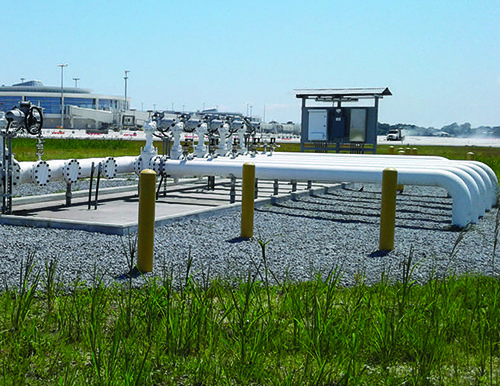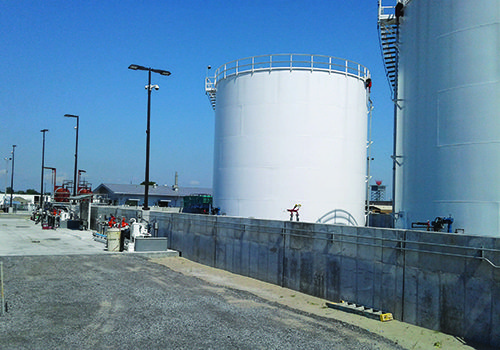While a striking new 972,000-square-foot terminal typically gets the glory when it comes to recent projects at Louis Armstrong New Orleans International (MSY), there’s more going on than the $1.029 billion capital improvement program. When operations move to the north side of the airfield this fall, a new hydrant fueling system and fuel farm will begin operating to support them.
While a striking new 972,000-square-foot terminal typically gets the glory when it comes to recent projects at Louis Armstrong New Orleans International (MSY), there’s more going on than the $1.029 billion capital improvement program. When operations move to the north side of the airfield this fall, a new hydrant fueling system and fuel farm will begin operating to support them.
 The $46 million investment by New Orleans Fuel Facility, MSY’s fuel consortium chaired by Southwest Airlines, has been carefully synchronized to move in lockstep with the construction of the new 35-gate terminal and ramp. That means that delays in the opening date of the terminal—four as of late May—have required the team designing and constructing the fuel upgrades to remain dynamic and flexible.
The $46 million investment by New Orleans Fuel Facility, MSY’s fuel consortium chaired by Southwest Airlines, has been carefully synchronized to move in lockstep with the construction of the new 35-gate terminal and ramp. That means that delays in the opening date of the terminal—four as of late May—have required the team designing and constructing the fuel upgrades to remain dynamic and flexible.
“For us, our main goal has been to be up and operational, regardless of the start date,” says Madelyn Tackett, fuel category manager with Southwest Airlines. “We have no control over when the terminal opens, but we don’t want any delay to be a fuel delay.”
|
facts&figures Project: New Fuel Farm & Hydrant System Location: Louis Armstrong New Orleans Int’l Airport Cost: $46 million Programming, Planning Design, Bidding, Construction Administration: Argus Consulting General Contractor: Kinley Construction Group Fuel Consortium: New Orleans Fuel Facility Consortium Chair: Southwest Airlines Fuel Operator: Menzies Architecture: Corgan Ramp Designer: Atkins Geotechnical Design: PSI Engineering Structural Engineering: Thomas F. Heausler Structural Engineering Corrosion Protection Engineering: Kadlec Associates Corrosion Engineers |
Simulation Plays Role in Solution
When officials decided to build a new terminal on the north side of the airfield in 2013, New Orleans Fuel Facilities contracted Argus Consulting to conduct a study evaluating the most efficient and cost-effective means to receive, store and dispense jet fuel to aircraft at the new terminal. “All of the existing fuel facilities are on the south side of the field, essentially next door to the existing terminal,” relates Paul Johnke, an Argus director. Ultimately, Argus also provided programming, planning design, bidding, construction administration and resident engineering services for the project.
The company conducted extensive simulation modeling based on flight schedules of the hydrant system and vehicle operations data to analyze several alternatives. The two main options that emerged were direct tank truck delivery to aircraft and hydrant delivery.
Without an internal airport circulation road, trucking fuel from the existing south side location to the new terminal on the north end would have required fuel trucks to exit the airport, drive on public roadways and then reenter the operations side on the north side of the property. Depending on traffic, the one-way drive could have taken up to 40 minutes, Johnke relates.
Argus worked closely with the fuel consortium and Menzies, the fuel operator at MSY, to estimate the price of both options. Continuing to operate as they were in 2014 included high variable costs (vehicles and people), but low capital costs. Conversely, the hydrant system had higher capital costs, but lower variable costs. Ultimately, the analysis showed that a hydrant system would be more efficient and cost-effective.
Several other factors also supported a hydrant system as the optimal choice, including lack of available space on the north side of the airport, limited access from the south side to the north side of the airfield and the ability to install the new piping system and pits before the new terminal ramp.
“With the new airport opening, it gave us the opportunity to go with the hydrant system,” Tackett relates. Although it requires a significant upfront investment, hydrant fueling is the safest, preferred method to deliver fuel and is more economical over the long term with an airport of this size, she adds.
Safety was the primary goal when designing the hydrant system, followed closely by operational efficiency, says Tackett. Serving a new terminal on a greenfield site gave the fuel consortium flexibility to construct a system specifically designed for MSY’s needs (80 million gallons of fuel annually), with up-to-date technology. Providing a safe and efficient operating environment for all was key, emphasizes Tackett.
From the safety side, for example, parts of the hydrant system can be segregated and shut down during an emergency while still allowing operations at the non-impacted gates.
System-wide Upgrades
Once the decision was made to construct a hydrant system, Argus focused on right-sizing the system to ensure economical operation with an ability to expand with the airport in the future. Argus used simulation modeling to right size the system’s components, including the pump/filter-separator trains, tanks and transmission lines based on passenger and flight forecasts.
To support the anticipated increase in demand for jet fuel at the airport, the project included significant expansion of the existing tank farm, including the construction of:
- two new 10,000-barrel aboveground tanks,
- five 750-gallons-per-minute hydrant system pump/filter trains,
- one 800-gallons-per-minute inbound pipeline receipt filtration train,
- two tank truck offload stations and
- a 2,700-square-foot administration/operations/maintenance building with a control room that provides a view of the tank farm.
The new building houses a central control room, offices, locker rooms, a break room, an electrical equipment room and a foam fire protection room.
“We wanted something that was going to also be a really good working environment for our operators,” Tackett explains. Now operations, maintenance and administration are all housed in one facility, which will streamline communication and cross training.
Additionally, the project included upgrades to the two existing 5,000-barrel aboveground tanks, the existing four-position remote refueler load rack, the communications system between the load rack and tank farm, as well as the load system and the addition of a foam fire protection system and a hydrant cart test stand.
The hydrant system provides fueling for the new 35-gate terminal on the north side of the airfield, with five emergency shutdown zones, each with 10-inch mains. The new system also includes an isolation valve manifold for the eventual extension of the system to service a future Concourse D. The tank farm and terminal hydrants are connected by one mile of new dual transmission 12-inch pipelines beneath Runway 11-29 and two taxiways installed by horizontal directional drilling. The drilling pits were located outside of the runway safety areas and object-free areas to avoid impacting airfield operations. Additionally, much of the most sensitive work was performed overnight, reports Johnke.
A new tightness testing system will be used to monitor the fuel system overnight, while the airport is down, to make sure the system is maintaining a safe operation, Tackett notes.
Careful Choreography
Design and construction of the hydrant system was fast-tracked, so it wouldn’t affect construction of the new terminal’s ramp. Argus, Kinley Construction and New Orleans Fuel Facility worked closely with stakeholders to avoid delays. “We choreographed the construction almost continuously with [ramp and terminal contractors] to make sure we were moving just ahead of them,” Johnke says. “We were very concerned about getting the fuel infrastructure under the pavement in time so we wouldn’t impede construction of the ramp.” At times, that required weekly meetings between both project teams, and adjustments to the original fuel system construction schedule.
“We’ve been tracking the opening date and adjusting our schedule,” Johnke adds. The multi-phase project eventually spawned “microstages” as the fuel team and terminal team coordinated to keep both projects moving as smoothly as possible.
Just after construction of the hydrant system began, MSY expanded the terminal project from 30 gates to 35. “We were in the middle of construction on the under-ramp fuel infrastructure when the decision was made to include Concourse A,” Johnke recalls. Because the design included provisions for future expansion, the project team was able to respond quickly to the change.

Soil Prep Requires Unique Solutions
Geotechnical conditions of the region posed a particular challenge to construction, relates Larry Crisafulli, vice president, Kinley Construction Group.
“The biggest challenge, and I think the challenge for everybody, was the soil conditions,” Johnke agrees.
Because of poor soil conditions, the terminal construction team surcharged the site with about 8 feet of sand to consolidate the soil and push out water prior to construction. The surcharge eliminated a lot of settlement, but potential remains for more over the next 25 to 30 years, Johnke notes. The hydrant system’s design addresses that potential. “We performed a stress analysis on our piping based on the anticipated remaining settlements and designed our system to keep the stresses within the allowable limits,” he explains.
 Design solutions like piles for foundation support and expansion joints in fuel pipe at below ground to above ground transitions were employed, Crisafulli adds.
Design solutions like piles for foundation support and expansion joints in fuel pipe at below ground to above ground transitions were employed, Crisafulli adds.
Pile supports were used for the two new 10,000-barrel tanks and associated containment structures, the equipment pad, inbound filtration system pad and tank truck offload system pad.
A secondary concern regarding the poor soil conditions was differential settlement with the transition off of pile-supported structures onto soil that is essentially settling or sinking. To meet that design challenge, Argus analyzed the anticipated settlement and designed several sets of ball joints to accommodate the transition and possible settlement.
“Everything that is pile supported is going to have very slight amounts of settlement—almost imperceptible,” comments Johnke. “It’s not an exact science—geotechnical is more a modeling and forecasting type business.” The ball joints, much like a human elbow joint, are designed to accommodate movement without inducing any stress from one part of the system to another, he explains.

“Once you’re off of the piles, everything is generally going to settle uniformly. But it’s just that initial transition from the pile-supported structure to the unsupported systems where you have to be concerned,” he adds.
The same concept extended to the fire protection systems and fire foam room in the operations and maintenance building. “We had to design the domestic water from the street coming in with flexibility so we wouldn’t break that connection—because the building was supported on piles,” says Johnke. “If the water line coming in from the street were to settle, we wouldn’t want to have a break in that.” The same applies to the foam and water-cooling lines exiting the fire protection room—they also have ball joints to accommodate potential settlement in the ground.
Breaking from tradition, the emergency fuel shutdown valve system is located aboveground. Often, such safety systems are located underground in vaults; but the high water table and associated potential for flooding prompted designers to house the motor-operated valves aboveground, away from the terminal.
Concurrent Operations
Delays to the opening of the North Terminal have made things “tricky” on the fuel side, Tackett acknowledges. While the new fuel facilities have to be up and running to service the new terminal, the existing facilities also have to remain operational in the meantime. “The challenge is put on my general manager out there,” relates Tackett. “She’s done a great job of coordinating efforts and working with the airport, as well as our engineering firm and construction folks.”
Sequencing and planning construction of the new system with stakeholders while supporting operations of the existing system has been a challenge, Crisafulli agrees.
 Due to the dynamic nature of the project necessitated by terminal opening delays, there was no such thing as over-communicating, says Johnke. “We found that it was better to invest in communication so that we can be agile and flexible.”
Due to the dynamic nature of the project necessitated by terminal opening delays, there was no such thing as over-communicating, says Johnke. “We found that it was better to invest in communication so that we can be agile and flexible.”
Working in an operational tank farm to construct the new and upgraded system required careful coordination and constant communication, he stresses. “We were really dependent on the operator,” Johnke recalls. “Menzies has been a great partner in helping Argus and Kinley be able to complete the construction.”
With so many moving parts, Tackett concurs that consistent communication was vital. “The coordination effort that has gone into this project has been huge,” she comments. Often, the fuel project team had to postpone certain work until the terminal and ramp project teams completed theirs. Not wanting to waste time or resources, the fuel project team remained flexible and accommodating to best use its assets, says Tackett.
Once a firm opening date is established for the new terminal, the next challenge will be providing a seamless transition from existing fuel system operations to the new system, without interruption to service.



